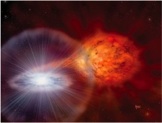

External links |
MINBAR /
Thermonuclear burst observations for model comparisons: a reference sampleThis page presents observations of thermonuclear (type-I) X-ray bursts, selected from the Multi-INstrument Burst ARchive (MINBAR) sample, for comparison with numerical models. The accompanying paper has been published by PASA and can be found at Galloway et al. (2017; preprint version at arXiv:1703.07485). The light curves are also available in the PASA data store. We selected three well-studied burst sources, which span the range of theoretical ignition cases identi fied observationally (see the Table below). We also selected a fourth source to serve as an example of a superburst, 4U 1636-536, which is notable for the only such event observed at high sensitivity with RXTE. Provided are examples of four distinct cases of thermonuclear ignition: He-ignition in mixed H/He fuel (case 1 of Fujimoto et al. 1988); He-ignition in pure He fuel, following exhaustion of accreted H by steady burning (case 2); ignition in (almost) pure He accumulated from an evolved donor in an ultracompact system; and an example of a superburst, thought to arise from ignition of a layer of carbon fuel produced as a by-product of more frequent bursts. For regular bursts, we measured the recurrence time and calculated averaged burst profiles from RXTE observations. We have also estimated the recurrence time for pairs of bursts, including those observed during a transient outburst modelled using a numerical ignition code. For each pair of bursts we list the burst properties including recurrence time, fluence and peak flux, the persistent flux level (and inferred accretion rate) as well as the ratio of persistent flux to fluence. In the accompanying material we provide a bolometric lightcurve for each burst, determined from time-resolved spectral analysis. Along with the inferred or adopted parameters for each burst system, including distance, surface gravity, and redshift, these data are suggested as a suitable test cases for ignition models. You may have reached this page following a link from Duncan Galloway's poster at the 2018 JINA-CEE Frontiers meeting, or at the Nuclei in the Cosmos meeting in 2016 June. Here is a link to the Frontiers poster PDF as well as the 2016 NIC poster PDF. This project is part of a broader campaign to reconcile burst observations and modelling, and also incorporate uncertainties related to the underlying nuclear reactions. The project is being pursued via a collaborative international team supported by the International Space Science Institute in Bern, Switzerland, and also via a Joint Institute for Nuclear Astrophysics Centre for the Evolution of the Elements (JINA-CEE) MA2 sub-project. Source tableTable 1: Target thermonuclear burst source properties. Values in italics indicate there are no constraints specific for that source.
References: 1. Heger et al. 2007; 2. this work; 3. Kuulkers et al. 2003; 4. Cumming 2003; 5. Özel et al. 2016 Burst tableTable 2: Properties of thermonuclear bursts observed from target sources by the Rossi X-ray Timing Explorer. Yes, this table is ugly; the one in the paper looks much nicer
a burst index number in the catalog of Galloway et al. (2008) The anticipated procedure to replicate each of the burst measurements in Table 2, as follows
In the event that the model recurrence time is significantly longer (shorter) than the observation, the cause may be that the true accretion rate is different from the estimate due to the unknown degree of anisotropy $ \xi_p $ of the persistent emission. In that case, the adopted accretion rate might be increased (decreased), by roughly the ratio of the predicted and observed recurrence times, and the procedure repeated from step 2 onwards until agreement (to within the uncertainty) between the predicted and observed recurrence times is achieved. Additional notes and errataThe gravity value quoted in Table 1 of the paper is redundant (and incorrect in the case of GS 1826-24). The value of $ g $ is set uniquely by the redshift and neutron star radius. The $ g $ column has been removed from the table here. back to the home page |
||||||||||||||||||||||||||||||||||||||||||||||||||||||||||||||||||||||||||||||||||||||||||||||||||||||||||||||||||||||||||||||||||||||||||||||||||||||||||||||||||||||||||||||||||||||||||||||||||